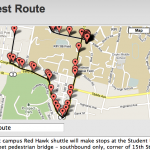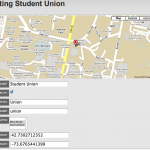I found myself on a plane a few days ago and was hoping to do some work on a few of my Ruby on Rails projects, primarily some polishing of the the Community Mapping project I’m launching later this week. Here are a few tips / tricks to developing in Ruby on Rails without internet access:
- Clone / Pull / Update the code for your application locally. I do almost all of my development on remote servers so it’s rare I have the latest of anything on my hard drive. git clone / git pull is a must to make this happen. If you don’t have your SCM tool installed (like git, svn, hg. etc) you need to do this ASAP.
- Bundle. Bundler helps maintain the dependencies in your applications plugins / libraries but to do that is usually needs to download libraries from the internet unless you have them installed locally. If you’re short on time (i.e. waiting to board the airplane) I would run bundle install from the app that has the most libraries associated with it. Bundler will reuse things that are already installed and if you’re lucky many of your applications share common libraries. The more wifi time you have the more applications you should bundle before you try and do it offline.
- Try and find any useful wiki / documentation pages that aren’t generated from source code. These pages are likely going to include examples of implementations and features not associated with a particularly function. In my case, I know there is a wiki page on Github that describes a “best approach” to the problem I’m having right now, but I can’t get to that in the airplane. I tend to have the most trouble with jQuery-based documentation… when ever I need to know the syntax for a function like $.ajax I just google it. Not possible on an airplane. Instead of waiting til I land to quickly fire up wifi before dashing to my connecting flight (that’s my current plan), I could have been smart and downloaded the documentation first. http://www.jqapi.com/ or http://docs.jquery.com/Alternative_Resources may be worth exploring.
- Don’t worry about the framework / gem documentation, at least not the function-by-function style documentation that is generated automatically. You can regenerate it on your own if you need to. The Ruby on Rails documentation can be generated by running `rake doc:rails` from your application directory. You’ll find the output in your apps doc/api directory. If you need documentation for a gem your system might already have it. Run `gem server` to start a server with information about your gems. If the rdoc link isn’t working for the gem you’re interested in fear not, you generate it most of the time using `gem rdoc gemname`. I needed the documentation for CanCan so I ran `gem rdoc cancan` and presto, the server was able to point me to some moderately useful information.
- Hack it if you have to. If you forget step 3 and step 4 didn’t help, you can probably write some really sloppy code to do what you’re trying to. If you can’t (or don’t want to) write some junky code perhaps you can simulate it. For example, I don’t know the exact call I need to figure out if I want to give the user access or not, but knowing that it will return true or false lets me very easily simulate what will happen in the rest of my application.
- Write lots of comments. You’re flying in an airplane. For all you know the baby crying behind you could be effecting your normal coding practices, it’s not going to be very easy to get back in the same mindset again so you should document what you’re doing extensively. This applies extra if you have to use step 5.
Best of luck with your offline development, and safe travels.

